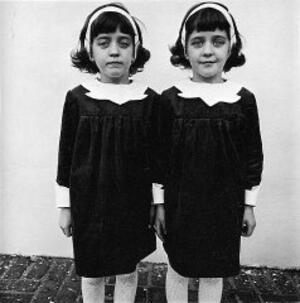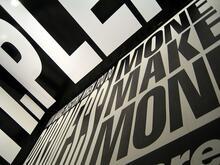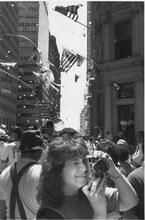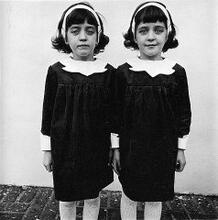Diane Arbus
Wildly controversial in her lifetime, Diane Arbus was only fully recognized for her contributions to the art of photography after her death. Arbus began work as a fashion photographer with her husband. Dissatisfied with purely commercial work, Arbus began making forays into the world of art photography, seeking out unconventional subjects such as Coney Island freak shows and gay bars, launching her solo career with her first photo essay for Esquire, “The Vertical Journey.” While Arbus was widely published in some of the best magazines in Great Britain and America, her controversial images also evoked powerful negative reactions. Suffering from depression and feeling overwhelmed by expectations of her work, Arbus committed suicide in 1971, but her work has continued to influence photographers for decades.
Diane Arbus changed how the world looks at photographs and how photographs look at the world. Best known for her pictures of “freaks” and eccentrics such as “The Jungle Creep,” “The Marked Man,” and nudists, she also changed the world of children’s fashion photography and celebrity photography. She was alternately described as shy, sweet and girlish or coldly aggressive and ”as tough as any man” in her field. Friends and colleagues were amazed by her ability to relate to her subjects, her openness and vulnerability with them. On the other hand, some people who posed for her found her to be manipulative, bossy, and cold. In a 1985 article titled “The Hostile Camera,” Calvin Bedient said of her: “She is a modernist heroine, braving the dark places of psychology, her only shield her camera, an eye that would not flinch.”
Early Life and Family
Diane was born on March 14, 1923, to Gertrude and David Nemerov. She was the second of three children, between elder brother Howard and younger sister Renee. All the Nemerov children grew up surrounded by the trappings of wealth and success. Their maternal grandparents started the Russeks fur stores their father now ran. Their only contact with their father’s side of the family (the poor immigrant Nemerovs) was when they would spend Passover in Brooklyn with David Nemerov’s parents. Later in life, Diane would frequently refer to the atmosphere of wealth in which she grew up. “I was confirmed in a sense of unreality. All I could feel was my sense of unreality,” she told interviewer Studs Terkel (in 1969). Her later career could be summed up as a constant search for the “reality” she was forbidden to see as a child.
Diane and her siblings attended the Ethical Culture School and the Fieldston School, both in Manhattan. At fourteen, Diane met nineteen-year old-Allan Arbus, who was working in the Russeks art department. They immediately fell in love and became intensely involved with one another. Though her parents tried to discourage the affair (much as her grandparents had tried to stop her parents), Diane and Allan continued to meet clandestinely for the next four years. On April 10, 1941, when she was just eighteen, Diane and Allan Arbus were married by a rabbi. Her parents, faced with this fait accompli, gave their blessing to the marriage. The Arbuses were married for twenty-eight years, although they separated after nineteen, and had two children, Doon and Amy.
Early Photography Work
In 1946, after Allan returned from World War II, the couple decided to pursue a career as fashion photographers. David Nemerov gave them their first job, the account with Russeks Furs. Over the next ten years, the Allan and Diane Arbus Studio became very successful, with Diane conceiving the style of the shoot and Allan handling the technical side. Allan, for his part, always encouraged Diane to take her own pictures and pursue her own creativity. Diane herself credited Allan as being “my first teacher.” However, Diane hated the world of fashion photography and began to suffer increasingly from depression (as had her mother). In 1957, she quit styling the Arbus Studio photoshoots
Moving into the world of independent photography was not easy for her. Diane Arbus was extremely shy, which hampered her ability to approach strangers on the street to ask them to pose. In addition, pursuing her own career went against the model of women at the time. As her daughter Amy has remarked: “Ma had always thought all her life was about helping Pa do his thing. It took her a long time to adjust.”
By 1960, Diane and Allan Arbus had separated, though Allan continued to be a major emotional support in her life. He also continued to assist Diane with her photography and taught her the technical side of the art.
Independent Career
To develop herself as a photographer, Arbus first enrolled in Alexey Brodovitch’s workshop, but she quit soon after she started. Her next attempt was more successful. In 1958 she enrolled in Lisette Model’s class at the New School. In Model, Arbus found her mentor and a lifelong friend. Model helped her identify and accept what subjects she wanted to photograph—what Doon Arbus later called “the forbidden.” Art critic Peter Bunnell has said that Arbus “learned from Model that in the isolation of the human figure one can mirror the essential aspects of society.”
In 1959, she met her second mentor, Marvin Israel, and he quickly became one of the major influences in her life. He supported her ideas and pushed her to pursue them even further. He advised her on which photograph to choose from a contact sheet and introduced her to people he thought would influence her or help her career. In 1961, he became the art director of Harper’s Bazaar and was able to publish her work as well.
Perhaps because of Model’s and Israel’s support, Arbus began to use her fear as opposed to being frozen by it. Throughout the rest of her life she would talk of her photography as an adventure and the fear as a stimulus. Her biographer Patricia Bosworth notes, “Her terror aroused her and made her feel; shattered her listlessness, her depression. Conquering her fears helped her develop the courage she felt her mother had failed to teach her.” Driven by her curiosity and fear, Arbus began to haunt the places that would define her as a photographer: Hubert’s Freak Museum in Times Square, Coney Island, gay nightclubs, and the tenements of Brooklyn and Manhattan. She began her life as a self-described “collector,” viewing her work as “a sort of contemporary anthropology.”
Career Success and Rise to Fame
In the late summer of 1959, Arbus took her portfolio to Esquire magazine and showed it to Harold Hayes, the articles editor. Hayes was “bowled over by Diane’s images. … Her vision, her subject matter, her snapshot style were perfect for Esquire, perfect for the times; she stripped away everything to the thing itself. It seemed apocalyptic.” A few months later, Arbus was asked to do a photo essay on the nightlife of New York for a special Esquire issue on the city, published in July 1960. It contained Diane Arbus portraits of six “typical” New Yorkers, titled “The Vertical Journey: Six Movements of a Moment Within the Heart of the City.”
“The Vertical Journey” marked the beginning of her career as a solo commercial photographer. Over the next eleven years Diane Arbus would publish over 250 pictures in more than seventy magazine articles. Her most frequent supporters in the publishing world were Esquire, Harper’s Bazaar, and two London publications, the Sunday Times Magazine and Nova. Her work also appeared in New York, Show, Essence, the New York Times, Holiday, Sports Illustrated, and the Saturday Evening Post.
Throughout her career, Diane Arbus hoped to break the pattern that bound most photographers. She tried to make a living from magazines while still maintaining her integrity and pursuing her style and interests, and to some degree, she succeeded. Her serious artwork and her magazine work were never as separate and distinct as that of most other photographers.
As the magazine assignments and her friendships with Lisette Model and Marvin Israel began to help Arbus feel more confident, she developed her own singular approach to photography, both artistically and technically. In 1962, Arbus changed her camera from a Leica to a Rolleiflex. The negatives were less grainy and gave her the clarity she wanted. The square frame of this new camera became a signature of her later work. In 1964, she began using a Mamiya C33 camera along with her Rollei. She used the Mamiya with a flash, which gave her subjects the exposed and vulnerable look that became another signature of her style. By 1970, she was taking photographs with a Pentax.
In 1965, three of Arbus’s early pictures were included in a show at the Museum of Modern Art called “Recent Acquisitions.” Arbus was hesitant and concerned, as she would be throughout her career, about the public’s reaction. She was right. Yuben Yee, the photo department’s librarian, would come in early every morning to wipe the spit off the photos. When Arbus learned of this, she left town for several days. As Yee said, “People were uncomfortable—threatened—looking at Diane’s stuff.”
Over this period, Arbus was getting work from magazines to do portraits of the famous and a few children’s fashion shoots. She also received two Guggenheim Fellowships, in 1963 and 1966, to pursue her private work. While still taking photos of “freaks” and eccentrics, she was moving into other areas of identity. She began taking pictures of twins and triplets, of families and couples in Central Park, of the uptown and downtown art scenes and of nudist camps.
In 1967, the Museum of Modern Art asked Arbus to contribute to “New Documents,” a major exhibit of modern photography. Again, she was hesitant about putting her work on public display. At the same time, she became tremendously excited by the possibility for future work, which she hoped the exhibit might generate.
The critical response was generally positive, although Chauncy Howell of Women’s Wear Daily called it “grotesque.” Robert Hughes of Time said, “Arbus is highly gratifying.” In the New York Times, Jacob Deschin wrote, “Even her glamour shots … look bizarre. … At the same time there is occasionally a subtle suggestion of pathos, now and then diluted slightly with a vague sense of humor. Sometimes, it must be added, the picture borders close to poor taste.”
Unfortunately, although the “New Documents” exhibit did bring Arbus to the attention of the London Sunday Times Magazine, her fear that the exhibit might lead to the public misunderstanding her work was realized. With the notoriety of the “New Documents” show, Diane Arbus became more firmly established as the “freak” photographer, and publishers became increasingly shy of using her to photograph the subjects of their stories. A further blow to her commercial career came with the controversy over the “Viva pictures.”
In December 1967, Arbus was hired by the newly created New York magazine to photograph the actor Viva. Arbus ultimately gave the magazine several nude photographs of Viva, which were published in the April 29, 1968, issue. Viva, who felt she had been misled and lied to by Arbus, threatened a lawsuit but later dropped it. The public and advertisers were so upset that the magazine lost over a million dollars in advertising, most of which never returned to the publication. Journalist Tom Morgan says that those pictures were “watershed pictures. They broke down the barriers between private and public lives.”
In 1968, she was hospitalized with hepatitis. (She had suffered from it before, in 1966.) Weakened from the illness, she felt that she was losing her strength and independence. She became increasingly depressed. In 1969, her marriage to Allan Arbus was formally ended by divorce and the Arbus Studio was closed.
By 1970, Diane Arbus had become a legend among young photographers. She was teaching classes and workshops and giving lectures—generally not something she enjoyed, but she was in demand and needed the money. That year she won the Robert Levitt Award from the American Society of Magazine Photographers for outstanding achievement. She also began what would be one of the final projects of her career, taking pictures of mentally retarded adults at a home in Vineland, New Jersey. At first these photos seemed to exhilarate her, but soon she grew to hate the Vineland pictures, because she felt that the shots were “out of control.”
Depression and Legacy
Beyond her dismay over those photographs, there was the attention brought on by success. The May 1971 issue of ArtForum had published a portfolio of her pictures. Walter Hopps of the Corcoran Gallery in Washington, D.C., had persuaded her to agree to exhibit her work at the Venice Biennale in the summer of 1972. These projects only seemed to panic and depress her further. “She did say over and over again that now that she was getting better known people expected things of her and she didn’t want anyone to expect things from her since she didn’t know what to expect from herself and never would.”
Suffering from extreme depression, caught between her fear of fame and her need for money, and at a crossroads in her work, Diane Arbus committed suicide in her apartment on July 26, 1971, leaving the words “last supper” written across that date in her journal. Marvin Israel discovered the body on July 28.
A posthumous exhibit was mounted at the Museum of Modern Art in 1972, then traveled around the United States and Europe. In 2005, the Metropolitan Museum of New York mounted a major, comprehensive retrospective exhibition, entitled “Diane Arbus Revelations.” Since her death three books of her photographs have been published: Diane Arbus: An Aperture Monograph, Diane Arbus: Magazine Work, and Untitled. For many years she remained a cult figure, and it was not until the 1980s that her work came to be generally accepted. Her impact and influence will never again be considered marginal. She changed not only photography but how we identify each other as human beings.
Arbus, Doon, and Marvin Israel, eds. Diane Arbus: Magazine Work (1984).
Bedient, Calvin. “The Hostile Camera: Diane Arbus.” Art in America (January 1985).
Bosworth, Patricia. Diane Arbus (1984).
Bunnell, Peter. “Diane Arbus.” Print Collectors Newsletter (January/February 1973).
Deschin, Jacob. “People Seen as Curiosity.” NYTimes, March 5, 1967, sec. 2, p. 21.
Diane Arbus: An Aperture Monograph (1972).
Morgan, Susan. “Loitering with Intent: Diane Arbus at the Movies.” Parkett 47 (1996).
NAW modern.
Spring, Justin. “Diane Arbus.” ArtForum (February 1992).







